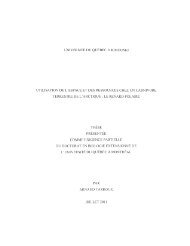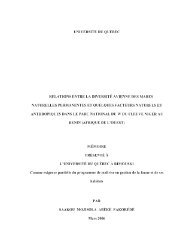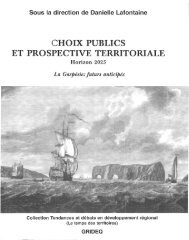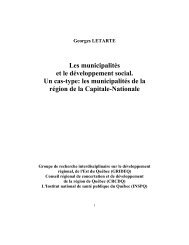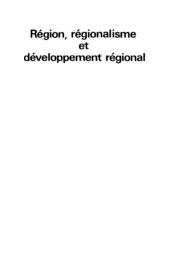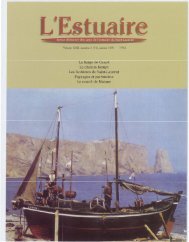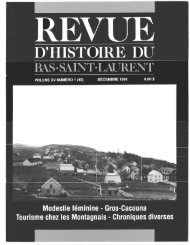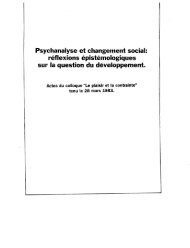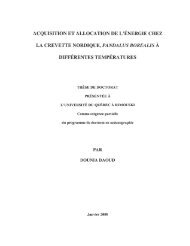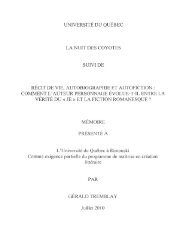influence du climat et de la prédation sur l'utilisation de l'habitat et la ...
influence du climat et de la prédation sur l'utilisation de l'habitat et la ...
influence du climat et de la prédation sur l'utilisation de l'habitat et la ...
Create successful ePaper yourself
Turn your PDF publications into a flip-book with our unique Google optimized e-Paper software.
83<br />
5.1. Abstract<br />
ln many mammals, juveniles are highly vulnerable to predators because of their low<br />
mobility and small body size. Use of <strong>de</strong>nse ground co ver by juveniles has been assumed to<br />
lower predati on risk. On the other hand, use of coyer <strong>du</strong>ring sunny summer days <strong>de</strong>creases<br />
access to radiative heat gain and may be d<strong>et</strong>rimental fo r juveniles that are sensitive to<br />
hypoth ennia. Studies re<strong>la</strong>ting use of coyer to <strong>sur</strong>vival of juveniles remain infrequent and<br />
have been essentiall y performed on ungul ates. We mea<strong>sur</strong>ed habitat selecti on and monitored<br />
<strong>sur</strong>v ival of 14 North American juvenile porcupines. We tested 1) wh<strong>et</strong>her juveniles selected<br />
for coyer at the microhabitat scale (within 1 m of the animal) and at the local scale (within 15<br />
m), 2) wh<strong>et</strong>her use of coyer <strong>de</strong>pen<strong>de</strong>d on m<strong>et</strong>eorological conditions, and 3) wh<strong>et</strong>her use of<br />
coyer <strong>influence</strong>d <strong>sur</strong>vival. We also examined how sex, body mass, mobility of the juvenile,<br />
and di stance b<strong>et</strong>ween juvenile and mother affected <strong>sur</strong>viva l. Our results indicate th at j uvenile<br />
porcupines selected microhabitats providing high protective coyer (microhabitat scale) within<br />
areas showing low herb co ver (l ocal scale). Use of coyer <strong>de</strong>pen<strong>de</strong>d on weather, with juveniles<br />
using <strong>de</strong>ns to avoid low air temperature and rain. Ten out of 14 juveniles di ed before the end<br />
of the summer and nine out of 10 <strong>de</strong>aths were <strong>du</strong>e to predati on. Habitat use (at both the<br />
microhabitat and local scales) <strong>influence</strong>d <strong>sur</strong>vival. At the microhabitat scale, use of protective<br />
coyer and use of trees enhanced <strong>sur</strong>vival compared to use of ground locations. At the local<br />
scale, use of sites with high shrub coyer enhanced <strong>sur</strong>vival. We fo und no effect of sex, body<br />
mass, mobility, and di stance to the mother on <strong>sur</strong>viva l. These results supp0l1 the hypothesis<br />
that predation was the main fa ctor limiting <strong>sur</strong>vival of juveniles in our popu<strong>la</strong>ti on and that<br />
predati on ri sk was mo<strong>du</strong><strong>la</strong>ted by habitat use of juveniles.<br />
Key-words : <strong>climat</strong>e, conditionallogistic regression, Er<strong>et</strong>hizon dorsatum, hi<strong>de</strong>r-fo llower<br />
behaviour, Québec, <strong>sur</strong>vival analysis<br />
5.2. Intro<strong>du</strong>ction<br />
ln <strong>la</strong>rge herbivores, juvenile <strong>sur</strong>vival is more sensitive to environmental variati on than is<br />
a<strong>du</strong>lt <strong>sur</strong>vival (Gaill ard <strong>et</strong> al. 2000, Eberhardt 2002, Gail<strong>la</strong>rd & Yoccoz 2003), and has been<br />
reported to p<strong>la</strong>y a fundamental role in driving the dynami cs of several popu<strong>la</strong>tions (Coul son<br />
<strong>et</strong> al. 1997, Gail<strong>la</strong>rd <strong>et</strong> al. 2000). Therefore, i<strong>de</strong>ntifying the causes of vari ati on in earl y



